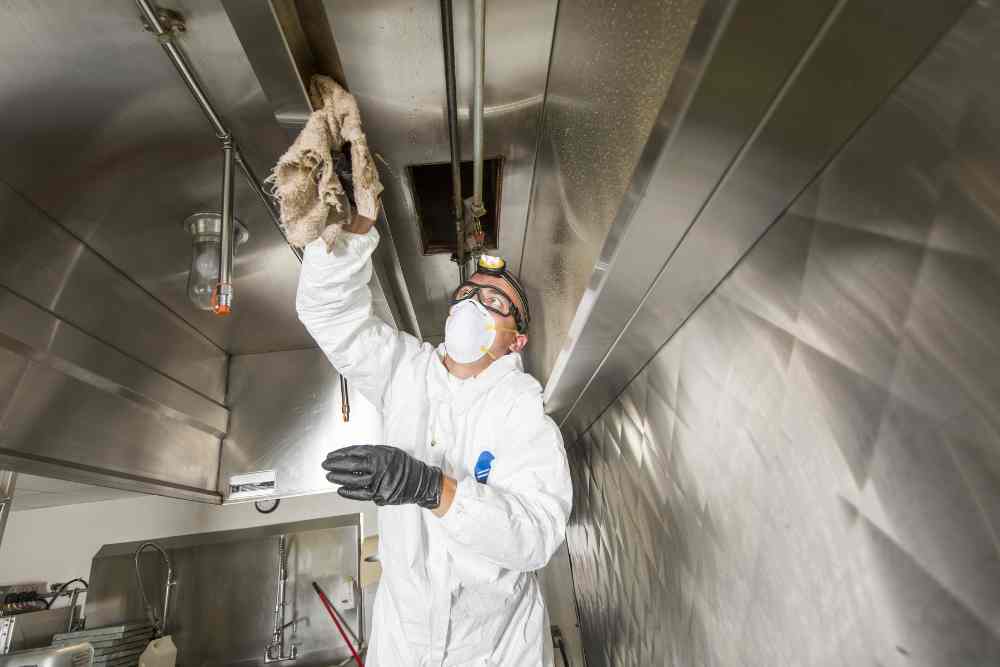Kitchen Ventilation Safety Protocols for Cleaning

Ontario-wide Kitchen Exhaust and Hood Cleaning – Best prices and service guaranteed.
Kitchen ventilation systems play a crucial role in maintaining a safe and healthy environment in commercial kitchens. These systems remove smoke, grease, and other airborne contaminants, ensuring that the air quality remains at an acceptable level. However, to ensure the effectiveness and longevity of these systems, proper cleaning and maintenance protocols must be followed. In this article, we will explore the importance of kitchen ventilation safety protocols for cleaning and provide valuable insights on how to maintain a clean and safe kitchen environment.
The Importance of Kitchen Ventilation Safety Protocols
Proper kitchen ventilation is essential for several reasons:
- Fire Safety: Grease buildup in kitchen exhaust systems can pose a significant fire hazard. According to the National Fire Protection Association (NFPA), nearly one-third of all restaurant fires are caused by grease buildup in the exhaust system. Regular cleaning and maintenance can help prevent these fires.
- Air Quality: A poorly maintained kitchen ventilation system can lead to poor indoor air quality, which can have adverse effects on the health of kitchen staff and customers. Proper cleaning ensures that smoke, odors, and other contaminants are effectively removed from the air.
- Energy Efficiency: A clean and well-maintained kitchen ventilation system operates more efficiently, reducing energy consumption and lowering utility costs. Regular cleaning can help prevent the system from becoming clogged, ensuring optimal performance.
Ontario-wide Kitchen Exhaust and Hood Cleaning – Best prices and service guaranteed.
Understanding the Cleaning Process
Proper cleaning of kitchen ventilation systems involves several steps:
1. Inspection
Before starting the cleaning process, it is essential to conduct a thorough inspection of the entire system. This includes checking the exhaust hood, ductwork, fans, and filters for any signs of damage or excessive grease buildup. Identifying potential issues beforehand allows for targeted cleaning and prevents further damage to the system.
2. Disassembly
Once the inspection is complete, the next step is to disassemble the various components of the kitchen ventilation system. This typically includes removing the exhaust hood, filters, and access panels to gain access to the ductwork and fans. Proper disassembly ensures that all areas of the system can be thoroughly cleaned.
3. Degreasing
The most critical part of the cleaning process is degreasing. Grease buildup in the exhaust system can be stubborn and difficult to remove. Using a high-quality degreaser specifically designed for kitchen ventilation systems is crucial. The degreaser should be applied to all surfaces, including the hood, ductwork, fans, and filters. It is important to follow the manufacturer’s instructions and allow sufficient dwell time for the degreaser to work effectively.
4. Mechanical Cleaning
After the degreaser has had time to work, mechanical cleaning techniques should be employed to remove the loosened grease and debris. This can involve using brushes, scrapers, and pressure washers to thoroughly clean all surfaces. Care should be taken to avoid damaging any components of the system during this process.
5. Filter Replacement
Filters play a crucial role in capturing grease and other contaminants. During the cleaning process, filters should be inspected for damage and replaced if necessary. Clean filters ensure optimal airflow and prevent grease from entering the ductwork.
6. Reassembly and Testing
Once all components have been thoroughly cleaned and inspected, it is time to reassemble the kitchen ventilation system. All connections should be securely fastened, and access panels should be properly sealed. After reassembly, the system should be tested to ensure proper airflow and functionality.
Ontario-wide Kitchen Exhaust and Hood Cleaning – Best prices and service guaranteed.
Frequency of Cleaning
The frequency of kitchen ventilation cleaning depends on several factors, including the type of cooking being done, the volume of cooking, and the type of kitchen ventilation system in place. However, as a general guideline, the NFPA recommends the following cleaning frequencies:
- Monthly: Systems serving solid fuel cooking operations
- Quarterly: Systems serving high-volume cooking operations, such as 24-hour cooking, charbroiling, or wok cooking
- Semi-annually: Systems serving moderate-volume cooking operations
- Annually: Systems serving low-volume cooking operations, such as churches, day camps, seasonal businesses, or senior centers
It is important to note that these are general guidelines, and the specific cleaning frequency should be determined based on the unique needs of each kitchen.
Case Study: The Importance of Proper Cleaning
A well-known restaurant chain recently experienced a devastating fire that originated in their kitchen ventilation system. The fire quickly spread throughout the restaurant, causing extensive damage and resulting in a temporary closure. An investigation revealed that the fire was caused by a buildup of grease in the exhaust system, which had not been properly cleaned and maintained.
This case study highlights the importance of following proper kitchen ventilation safety protocols for cleaning. Regular cleaning and maintenance could have prevented this fire and the subsequent damage to the restaurant.
Ontario-wide Kitchen Exhaust and Hood Cleaning – Best prices and service guaranteed.
Kitchen ventilation safety protocols for cleaning are essential for maintaining a safe and healthy environment in commercial kitchens. Proper cleaning not only reduces the risk of fires but also improves air quality and energy efficiency. By following the steps outlined in this article and adhering to recommended cleaning frequencies, kitchen operators can ensure the longevity and effectiveness of their ventilation systems. Remember, neglecting proper cleaning and maintenance can have severe consequences, as demonstrated by the case study. So, prioritize kitchen ventilation safety protocols and make it a top priority in your kitchen operations.
Check out this article on “What are the requirements for efficient kitchen exhaust ventilation” right here.
Frequently asked questions about Kitchen Ventilation Safety Protocols for cleaning

1️⃣ What Steps are Taken to Ensure Safety During Cleaning? 🛑
Great question! Safety is our number one priority. Before any cleaning takes place, we follow several steps:
- Turn off all relevant electrical and gas units 🚫🔌
- Place wet floor signs and create a safety perimeter to make sure no one accidentally walks into the cleaning area 🚷
- Use proper PPE like gloves, masks, and eye protection 👷♀️👷♂️
- Handle and dispose of chemicals in a safe and environmentally responsible way ♻️
Only then do we begin the deep cleaning process to make sure everything is sparkling clean and safe! ✨
2️⃣ How Do You Ensure Fire Safety During and After Cleaning? 🔥
Excellent question! Fire safety is a key concern. During cleaning, we make sure to thoroughly remove all the built-up grease, which is a major fire hazard. After cleaning, we perform a thorough inspection to ensure all electrical and gas connections are secure and that there’s no risk of a fire. 🚒
We also check the fire suppression system to make sure it’s in working condition. If we spot any issues, we’ll report it immediately so that it can be addressed. 🧯
3️⃣ What Certifications Should a Hood & Kitchen Exhaust Cleaning Technician Have? 📜
Look for technicians who are certified by recognized organizations like the International Kitchen Exhaust Cleaning Association (IKECA) or the National Fire Protection Association (NFPA). These certifications ensure that the technician has undergone rigorous training in both cleaning procedures and safety protocols. 🎓
Rest assured, as a certified business owner, my team and I hold these certifications and stay up-to-date with all the latest safety protocols. 🌟
4️⃣ Can I Continue to Operate My Kitchen While the Exhaust System is Being Cleaned? 🍳
In most cases, it’s best to schedule cleaning during off-hours to ensure the safety of both your staff and our cleaning team. Running the kitchen while cleaning is going on can introduce safety risks like slips and falls, or even accidental fire ignitions. 🚫
Don’t worry, we’re flexible and can work around your hours to make sure there’s minimal disruption to your business! ⏰
5️⃣ Do You Offer Emergency Cleaning Services? 🚨
Yes, we do! We understand that emergencies happen. Whether it’s an unexpected inspection or a sudden realization that your system hasn’t been cleaned in ages, we’ve got you covered. However, keep in mind that emergency services might come at a premium price due to the urgency and quick turnaround required. 🕐
But no worries, we’ll still uphold the highest safety standards, even when we’re racing against the clock! 🏁
- hood cleaning
- kitchen exhaust cleaning
- Kitchen Ventilation Safety Protocols for Cleaning
- restaurant hood cleaning






